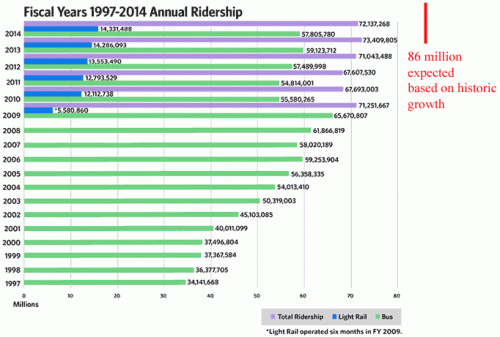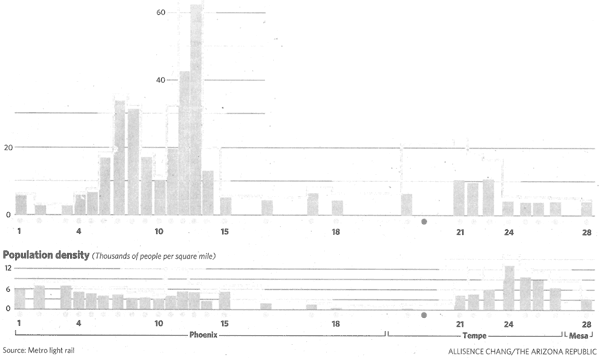Tampa Rail writes (hat tip to a reader):
The new Phoenix light rail system is emerging as one of the most successful new systems in the country. This is especially poignant for Tampa because in scale, project scope, and demographics, Phoenix represents the apogee of operating examples.
Over the course of its first year the system has received high marks in community integration, stunning ridership figures, and respectful financial constraint (making tough decisions on long-term planning that do not inhibit the value of its starter-line status today). This is exactly what Hillsborough County is shooting for in its own implementation. A perfect balance of conservative control and benchmarking combined with progressive action and democratic freedom, the latter which may finally come to Hillsborough County in the form of a referendum. That all good stuff was achieved by such a strikingly similar auto-depenent culture is a great omen. A starter light rail system can be championed by civic conservatives (Mark Sharpe), and civic progressives (Ed Turanchik) to great outcome....
Both pieces I link to here embarass anti-rail or anti-tax groups who are, as the Phoenix article notes, "muted" if not definetively silenced. Their arguments against community investement were loud, often intelligent (once one bought into the ideological premise that rail systems must 'pay for themselves' and that community investement is somehow inherently evil - points not firmly established by any means among rationale individuals), and grossly atypical. I will forever hype on how mechanical, unchanging, and how pre-web these attacks were formulated.
Ooh, how can I overcome my embarrassment? Look, I don't think I have ever argued that Phoenix Light Rail was run poorly or didn't have pretty trains. And I don't know if moving 18,000 round trip riders a day in a metropolitan area of 4.3 million people is a lot or a little (though 0.4% looks small to me, that is probably just my "pre-web" thinking, whatever the hell that is).
The problem is that it is freaking expensive, so it is a beautiful toy as long as one is not paying for it. Specifically, it's capital costs are $75,000 per daily round trip rider, and every proposed addition is slated to be worse on this metric (meaning the law of diminishing returns dominates network effects, which is not surprising in this least dense of all American cities).
Already, like in Portland and San Francisco, the inflexibility of servicing this capital cost (it never goes away, even in recessions) is causing the city to give up bus service, the exact effect that caused rail to reduce rather than increase transit's total share of commuters in that wet dream of all rail planners, Portland. Soon, we will have figures for net operating loss and energy use, but expect them to be disappointing, as they have in every other city (and early returns were that fares were covering less than 25% of operating costs).
PS- I get a lot of comments that I have some weird anti-train bias. Actually, I have an n-scale model railroad in one room of my house, and spent a lot of my teenage years traveling along rural rail lines and photographing trains. I love trains. I just don't like stupid investments.
PPS- I was just thinking, on the basis the Tampa writer declares the building of Phoenix Light Rail a raving success, I could say the same thing about buying a super-size 100" flat screen TV for $50,000. It is beautiful. Everyone who sees it will love it. It works flawlessly. Lots of people will be able to enjoy it at one time. In fact, it is the greatest, most sensible and successful purchase of all time as long as you never mention the cost. Which is, by the way, why only one person I have ever met has one (I happened to be at a Reason reception the other night and the homeowner had such a beauty on his living room wall).
Update: I try to anticipate every argument in these posts. The one other argument is that rails takes congestion off roads. But for most of its length, Phoenix light rail displaced one lane of road in each direction. These lanes had a capacity as large or larger than what Phoenix light rail carries. The were also much cheaper to build. I must say I liked my quote from that post
If running trains requires, as you suggest, draining resources from millions of people just to move thousands, how is it sustainable?


